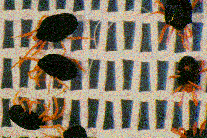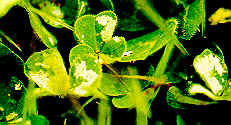
Part C - Insect pests of sub clover
ALWAYS READ THE LABEL
Users of agricultural (or veterinary) chemical products must always read the label and any Permit before using the product, and strictly comply with the directions on the label and the conditions of any Permit. Users are not absolved from compliance with the directions on the label or the conditions of the Permit by reason of any statement made or not made in this publication.
WARNING
Pesticide residues may accumulate in animals treated with any pesticide or fed any crop product, including crop residues, which have been sprayed with pesticides. In the absence of any specific grazing withholding period(s), grazing of any treated crop is at the owner’s risk. Withholding periods for stock treated with any pesticide or fed on any pesticide treated plant matter must also be observed. Pesticide residues may also contaminate grains, oils and other plant products for human use and consumption. Growers should observe harvest withholding periods on the pesticide label and should not assume that in the absence of a withholding period or after the expiry of a withholding period that the plant will be free of pesticide residues.
Redlegged earth mites and blue oat mites
Redlegged earth mites and blue oat mites have emerged as major pests of sub clover, particularly since the withdrawal of DDT as an insecticide. Both occur in southern NSW, but blue oat mite is more common in northern NSW. They can cause:
- death of young clover seedlings in autumn;
- reduced seedset in spring;
- loss of dry feed quality over summer if present on sub clover in spring.

There is variation in tolerance between cultivars, and the breeding program is attempting to develop cultivars that are more resistant. Newly sown stands must be protected with an appropriate insecticide when redlegged earth mite or blue oat mite are likely to be a problem (see warnings).

Guidelines are available which access the likelihood of redlegged earth mite hatchings based on weather conditions, and these should be used to minimise insecticide application while maximising insect control. Consult your District Agronomist or commercial agent for recommendations on controlling redlegged earth mite and blue oat mite.
Bluegreen aphid

Since its arrival in Australia, bluegreen aphid has emerged as a significant pest of sub clover, being capable of affecting growth and reducing seedset, sometimes severely. The reactions of commercial varieties to attack by bluegreen aphid are given in Table C1:
Table C1. Reaction of commercial varieties to attack by bluegreen aphid
| Sub clover variety | Reaction to attack by bluegreen aphid |
|---|---|
| Nungarin | MR |
| Dalkeith | S |
| Urana | – |
| Seaton Park LF | MS |
| York | S |
| Trikkala | S |
| Riverina | – |
| Gosse | MR |
| Napier | – |
| Rosedale | – |
| Junee | MS |
| Coolamon | – |
| Woogenellup | MS |
| Goulburn | MR |
| Denmark | MR |
| Leura | – |
| Clare | MR |
| Nuba | – |
| Mount Barker* | MR |
| Karridale* | MR |
| Meteora* | MS |
HS = highly susceptible
S = susceptible
MS = moderately susceptible
MR = moderately resistant
R = resistant
HR = highly resistant
* These varieties are superseded by newer varieties.
Spotted clover aphid

This aphid was first identified in Albany, Western Australia, in 1989 but has subsequently been found in the irrigation districts of southern NSW and in pastures in eastern Victoria. It is very similar in appearance to the spotted alfalfa aphid and can cause yield losses of up to 90%, with none of the commercial varieties having any resistance to this pest. It is important to control spotted clover aphid with insecticides if valuable clover pastures are threatened (see warnings).
Further information
For further information on subterranean clover, see the other sections of this Agfact:

